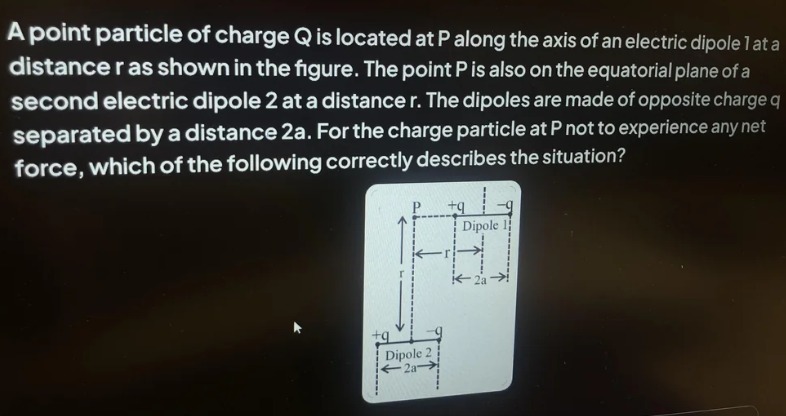Question
Question: A point particle of charge Q is located at P along the axis of an electric dipole 1 at a distance r ...
A point particle of charge Q is located at P along the axis of an electric dipole 1 at a distance r as shown in the figure. The point P is also on the equatorial plane of a second electric dipole 2 at a distance r. The dipoles are made of opposite charge q separated by a distance 2a. For the charge particle at P not to experience any net force, which of the following correctly describes the situation?

The net force on Q is zero if the two dipoles are arranged so that the field at P due to dipole 1 (on its axis) is exactly cancelled by that due to dipole 2 (on its equatorial plane). In the dipole‐approximation this requires that
r32p=r′3p⟹r′=21/3r,with the dipole moments (or equivalently the placement of the positive and negative charges) chosen so that the two fields are oppositely directed.
The net force on Q is zero if the two dipoles are arranged so that the field at P due to dipole 1 (on its axis) is exactly cancelled by that due to dipole 2 (on its equatorial plane). In the dipole‐approximation this requires that
r32p=r′3p⟹r′=21/3r,with the dipole moments (or equivalently the placement of the positive and negative charges) chosen so that the two fields are oppositely directed.
Solution
-
In the dipole approximation, the field on the axis is
Eaxis=4πϵ0r32p
and on the equatorial line it is
Eequ=4πϵ0r3p.
-
For a charge Q at P to experience zero net force the two fields must be equal in magnitude and opposite in direction.
-
Since the axial field is twice the equatorial field at the same distance, one must change the distance so that
r32p=r′3p
i.e.
r′=r/21/3,
or reverse the direction of one dipole.
